7 Ways to Feel Better
RIGHT NOW
Using Neuroscience
These 7 ways to feel better right now using neuroscience go beyond the vague tips we’ve all heard before, well-meaning yet often unhelpful advice repeated ad nauseum. These seven strategies actually work, and they work fast, altering brainwaves and dampening destructive stress responses in the body in matter of seconds.
1. Drink Tea
I don’t just drink tea because it tastes good. The beverage is a boon for the brain. And mood.
The tea plant otherwise known as camellia sinensis is one of the only edible substances in the world known to contain L-theanine, an organic compound occasionally nicknamed the “relaxation amino acid” courtesy of its remarkable calming effects.
See Also: Green Tea Weight Loss Miracle: Truth Or Hype?
And: Want a Better Memory? Do This
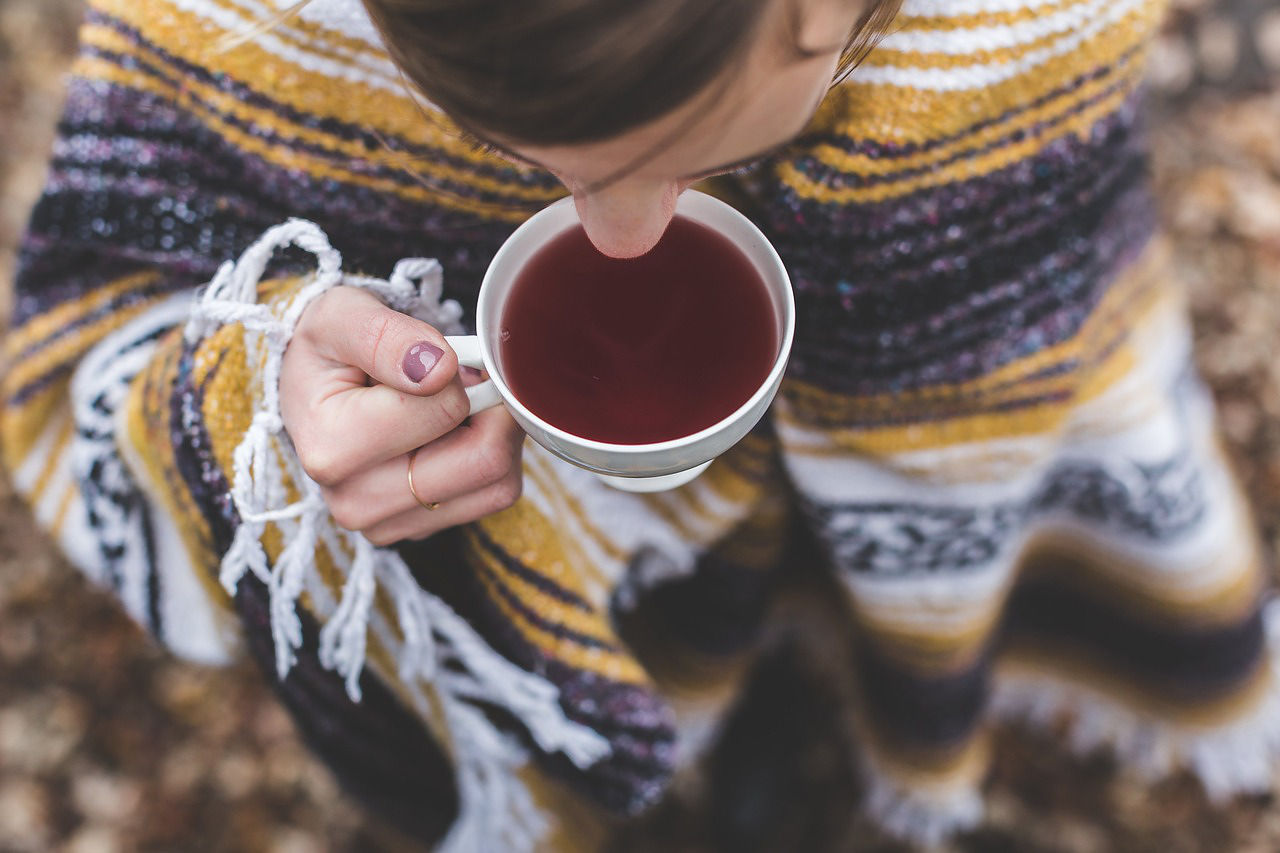
(Photo courtesy of Pixabay)
Traces of L-theanine have been found in a couple of flower species and the Bay Bolete mushroom, but good luck finding that fungus in abundance.
The beauty of L-theanine is it facilitates the generation of alpha waves in the brain [1, 2] the same kind of state that lifelong meditators (and elite athletes) can produce on demand. On topic, one of my best meditation sessions on record –call me a neurogeek, but I never tire of recording my brainwaves– occurred right after finishing up a café-au-lait-sized cup of matcha.
Coincidence?
What’s especially fascinating about being in an alpha state is its association with boosts of creativity and productivity devoid of feelings of anxiety, stress, and depression. Alpha brainwaves denote both a sense of relaxation and focused attention. Incidentally, evidence points to tea producing that very effect, a sense of calm and paradoxically, enhanced alertness. The best of both worlds, I say.
2. Breathe the Right Way
Breathing is so underrated. Most people do it wrong too. In fact, most people do it so wrong, they open themselves up to insomnia, neck, back, and shoulder pain, indigestion, memory problems, and even anxiety that could be minimized or maybe even put to rest altogether by fundamentally changing the way they breathe.
Author of Breathe, psychologist Dr. Belisa Vranich, certainly isn’t the first to suggest that breathing significantly changes brain function [3]. But she’s one of the first to explain how to do it the right way so simply. Delving into the anatomy of what Dr. Vranich qualifies as good breathing, she claims in the following two-minute clip that filling up your lungs “horizontally” rather than “vertically” is key to improving quality of life.
What’s especially fascinating about being in an alpha state is its association with boosts of creativity and productivity devoid of feelings of anxiety, stress, and depression. Alpha brainwaves denote both a sense of relaxation and focused attention. Incidentally, evidence points to tea producing that very effect, a sense of calm and paradoxically, enhanced alertness.
3. Acknowledge Panic Away
What do you do in the throes of a panic attack? Countless articles detail the process. I’ll share with you I figured out for myself through a combination of deduction and sheer dumb luck, in a time long ago before copycat how-tos proliferated on the web, a time before the creation of Youtube and even Google (I know, crazy talk).
So this is what killed my panic attacks as a first year psychology student. And if you fast-forward to Strategy #6 on this list, you’ll see that what I did has since been confirmed by neuroscience as effective.
The attacks started two weeks before I was about to be kicked out of home. It was a shock to the system. I wasn’t given enough notice to prepare nor build up sufficient savings to keep me afloat as I was about to start university. In the –for lack of a better word– panic to find a new home, I ended up taking the cheapest apartment I could find that wasn’t a complete dump.
It was in a public housing project complemented by a violent man prone to beating his mother to tears. They lived right above me and I could hear everything, the cries, the pleas, the punches, the wall slams. He didn’t take long to notice that I might make him an interesting mark too, right around the time I tried to convince his mother that a butcher knife aimed in her general direction might be a choice time for her to run and call the police. It was… not good.


(Top left photo courtesy of Pexels; top right, bottom left, and bottom right photos courtesy of Pixabay)


So what quashed my panic attacks? Awareness and loving kindness towards myself. Awareness was the realization that my reaction to the physical symptoms of a building attack was what escalated the situation into uncontrollable hyperventilation. And being gentle with myself by accepting that it was okay that this was happening was the loving kindness.
The first sign that I was about to have an attack was body heat. If I started to feel overheated and the next thing to happen was a rapid heart rate, it wouldn’t take long for shallow breathing to kick in. Seconds after that? The sensation that my chest was about to explode. The first time that ever happened, I thought I was dying, a horrifying sensation.
Learning to spot the signs that came before that crushing, breathless feeling was key. That’s awareness.
If I suddenly felt a little too hot or if my heart rate was speeding up without there being a valid physical reason for it, then it was my cue to consciously work on taking longer, slower breaths, the kind of inhales that make you feel like you’re filling up your belly, not your chest, precisely how Vranich advised in that breathing clip I posted above.
It took practice, but I was eventually able to “move through” the panic faster and faster.
If I was alone, I would talk to myself out loud too, saying things like “this will pass sweets, you’re fine, you’re okay, it’s a physical thing that happens to a lot of people, and you’ll get through it.” That’s loving kindness.
Even simply acknowledging to myself that “oh, you’re on the verge of a panic attack but it’s all good” or “oh, you’re having a panic attack and, hey, it’s okay” was enough to give me a gradual sense of control over my breath and an understanding that no matter how terrified I might feel, it can take but a matter of seconds to get into a better-feeling place.
In other words? This too, shall pass. And it did.
My life circumstances were still as taxing as ever, yet within weeks, the panic attacks were gone.
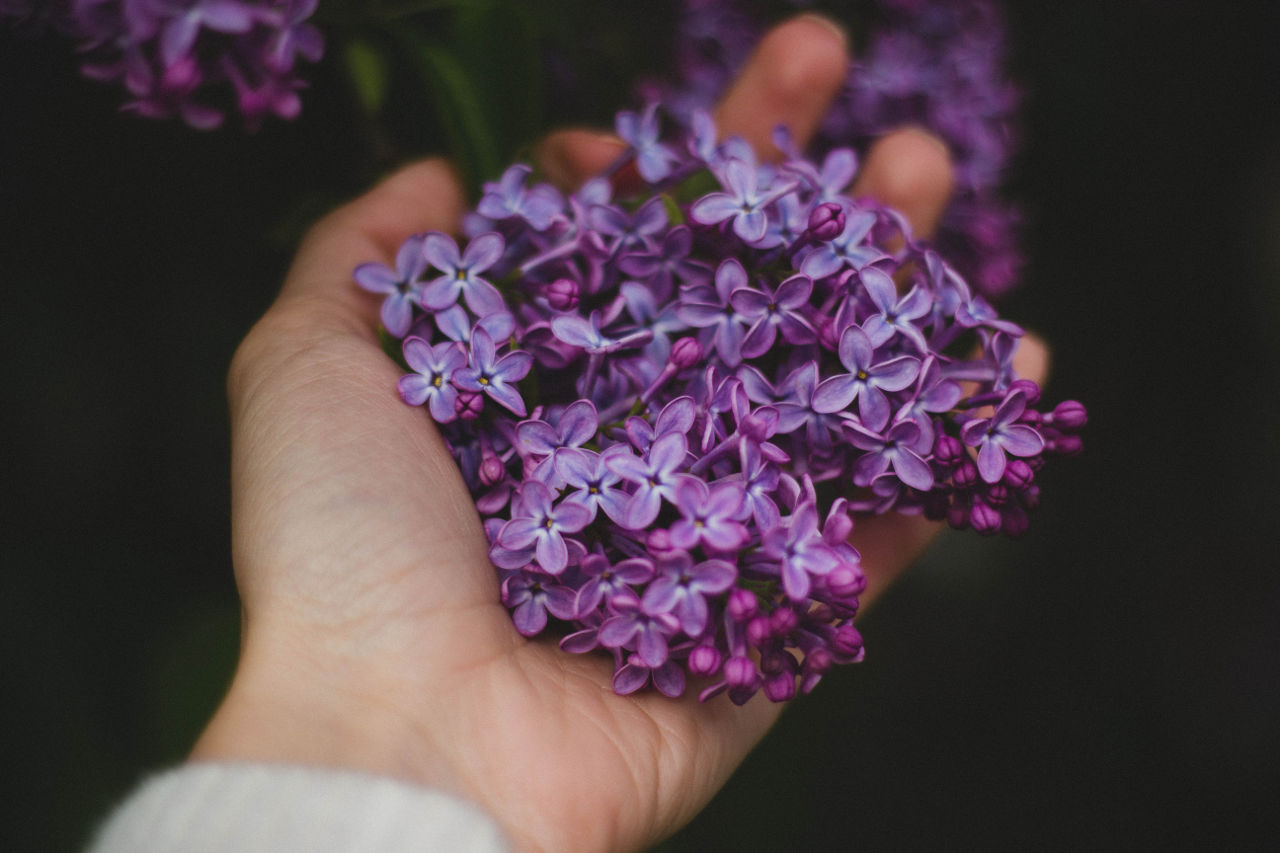
(Photo courtesy of Pixabay)
4. Stop and Smell the Roses Lavender
I don’t have a vial of the flower essence on my desk for nothing. Anecdotal claims qualifying lavender as a calming, mood-lifting agent have been put to the clinical test for decades.
Take a 2012 Thai study which discovered that subjects with 31 electroencephalogram (EGG) electrodes strapped to their heads showed sudden increased alpha and theta brainwave activity as they inhaled lavender oil, brain activity consistent with deep relaxation [4]. That’s also the kind of pattern you’d see an experienced meditator induce and sustain during a meditation session.
Participants who inhaled sweet almond oil in the same Thai study showed no such shift in brainwave activity.
Blood pressure dropped and heart rate activity also slowed down for lavender sniffers who reported “feeling better, fresher, more active, more relaxed, and less drowsy” afterwards.
All this, just from smelling the flower essence.
Meanwhile, the sweet almond oil group weren’t quite as delighted, describing the sensation as “unpleasant when sweet almond oil was applied, with data showing decreased scores in good, active, fresh and relaxed feelings.”
The study sample size, 20 people, is admittedly small, participants had their respective oils pumped through an oxygen mask –not quite the same as casually sniffing lavender at your desk, is it– and there is the possibility that researchers unwittingly affected the outcome of the study since its design was not double-blind.
But what if they’re onto something nonetheless?
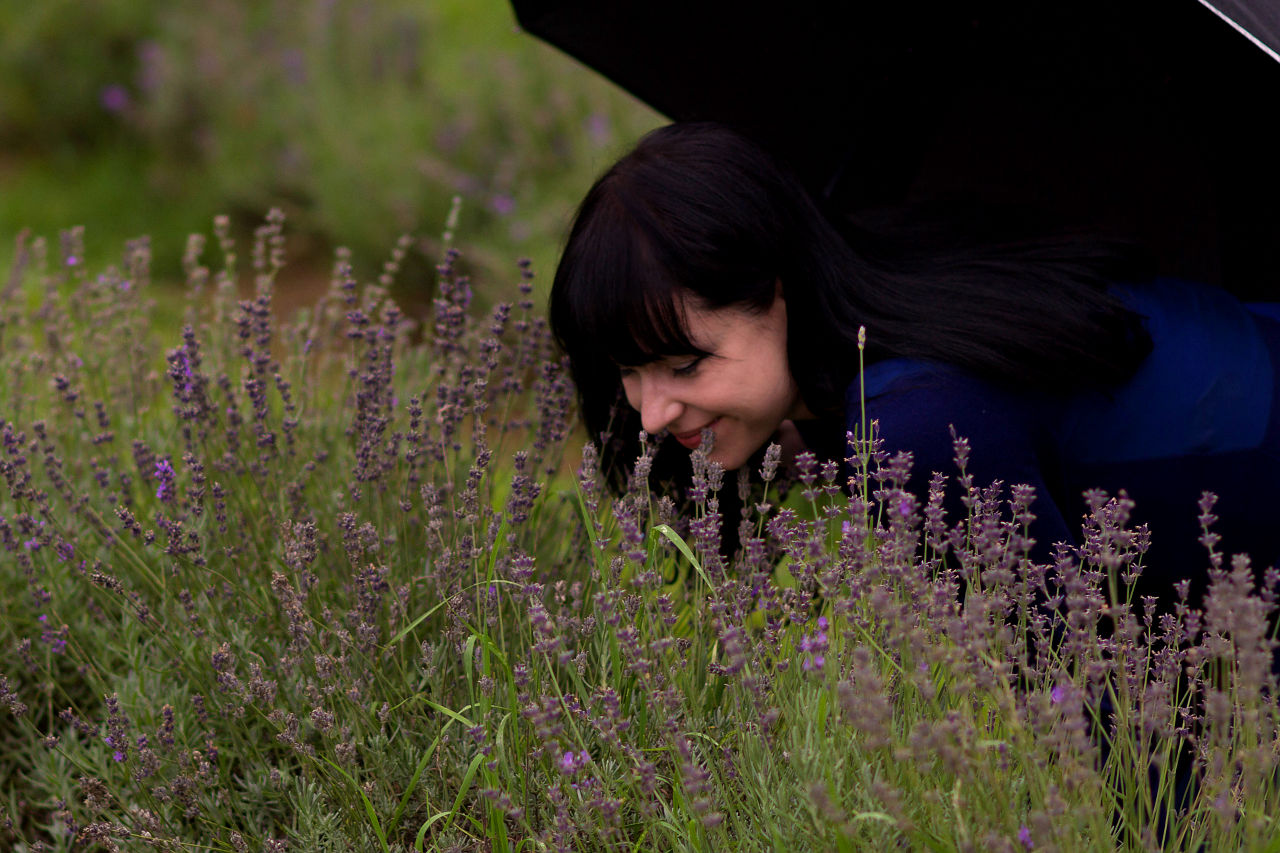
That’s me in a lavender field in the province of Quebec’s Eastern Townships.
(Photo © Clint Lewis)
A robust 2014 German study involving 539 patients diagnosed with generalized anxiety disorder (GAD) found that a lavender oil preparation called Silexan taken orally was as effective in treating anxiety over a 10-week period as paroxetine (aka Paxil) [5].
Paroxetine is an effective and popular antidepressant and antianxiety medication notorious for unpleasant, sometimes life-disrupting discontinuation symptoms experienced by about 20% of users weaning off the drug. In contrast, no withdrawal symptoms nor drug interactions have been found with the lavender oil preparation in a subsequent study conducted earlier this year [6].
Equally fascinating is how in 2010, a duo of German researchers who conducted a double-blind experiment involving 221 adults also diagnosed with GAD saw the same previously mentioned lavender oil preparation offer comparable relief from anxiety as Lorazepam (aka Ativan), a powerful benzodiazepine commonly prescribed for anxiety and insomnia [7]. Lorazepam offers relief, yes, but it also induces a woozy, dreamy, drowsy mental state that slows reaction time, leading to bouts of confusion and memory loss, hampering work performance, the ability to safely drive a vehicle, even interfering with the ability to carry on a conversation at times. Then there’s the high risk of addiction and rapid tolerance formation.
Lavender? None of these problems have been detected with ongoing use of the humble flower essence. Possible side effects discovered to date are nausea and dyspepsia if taken orally, and potential skin dermatitis if the essential oil is applied directly to the skin. But otherwise, that’s it.
The above is but a sliver of the surprising amount of research out there supporting lavender as an anxiolytic. The scientific and medical community are slowly, skeptically coming around as more solidly-designed studies come forward showing equally promising results.
At this point? The best case scenario is lavender really is all that, and possibly more. The worse case scenario is that evidence of its effectiveness in calming, reducing stress, enhancing focus, and improving the sleep of its users may be overstated.

(Photo courtesy of Pixabay)
5. Take a Hot Bath
Feeling low? Maybe even lonely? Get thee to thy bath.
An in-depth 2012 study conducted by Yale University demonstrated that warm or hot baths soothed feelings of loneliness [8].
And a 2002 University of Wolverhampton study [9], which saw psychologist Neil Morris evaluating the moods of 80 participants instructed to take daily baths for two weeks found “that bathing improved general psychological wellness radically. There was a significant drop in feelings of pessimism about the future and increases in hedonic tone, the internal feeling of pleasurability,” as per Morris [10].
He adds, “I believe that the results could be even more impressive over a longer period of time. Baths give you the chance to stop the day for a few minutes, in a way that showers can’t. There is a wonderful combination of isolation, quiet and comfort.”
And you’ll never guess what Morris had some participants add to the bathwater.
Lavender.
Those who did have lavender oil added to their baths showed greater drops in anger, frustration, and pessimistic thought towards the future than those who bathed with comparable amounts of grapeseed oil instead.
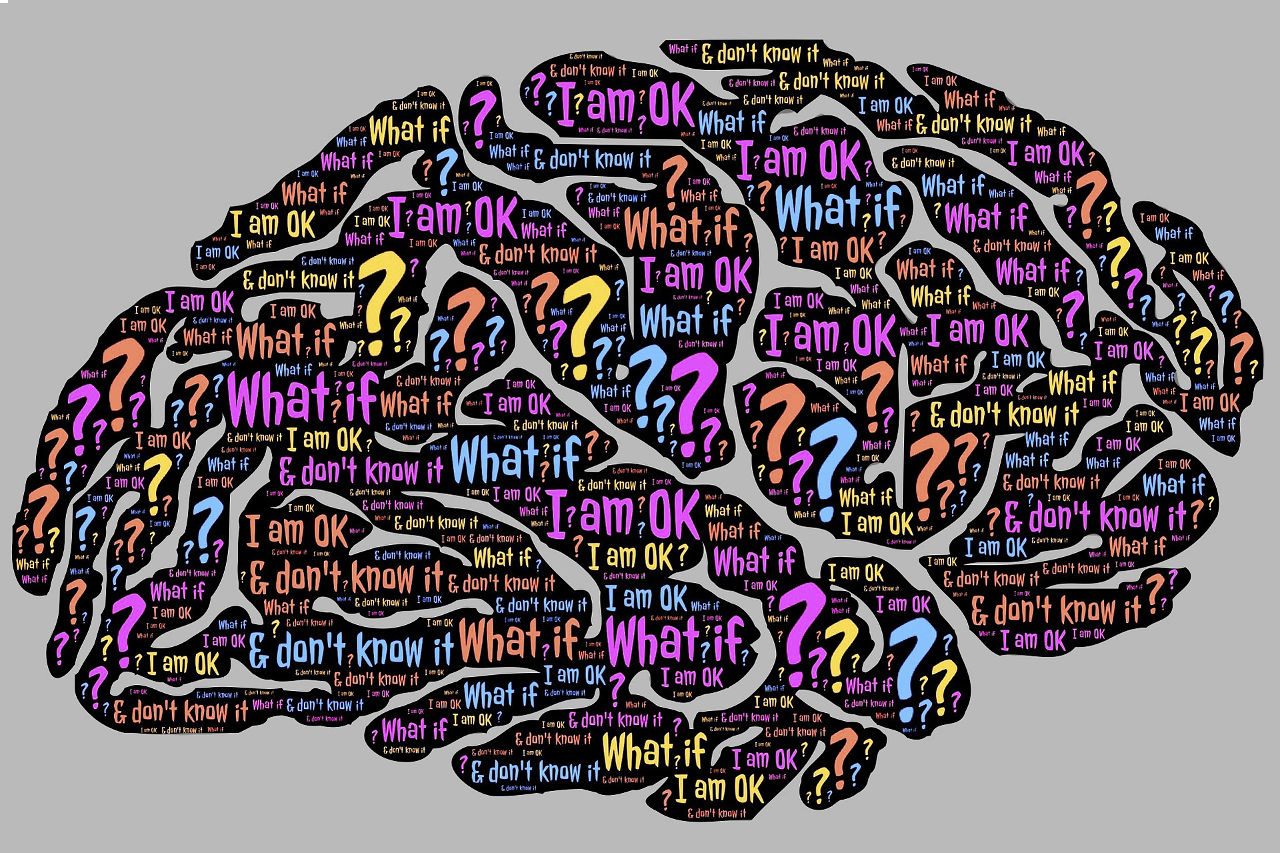
(Image courtesy of Pixabay)
6. Accept and Label Negative Emotions As They Happen
“Mindfulness is simply being aware of what is happening right now without wishing it were different; enjoying the pleasant without holding on when it changes (which it will); [and] being with the unpleasant without fearing it will always be this way (which it won’t).” -meditation teacher James Baraz
Remember what I said earlier about how acknowledging and accepting that I was experiencing a panic attack seemed to help me move through it? I was unwittingly engaging in a process called mindfulness. Yogis and Buddhist monks have been practicing it for generations and mental health professionals have taken note.
For example, a research team from University of California, Berkeley and University of Toronto [11] looked closely at the impact of acceptance, a facet of mindfulness [12]. They conclude in the report detailing a trio of studies published earlier this year in the Journal of Personality and Social Psychology that accepting negative emotions leads to less negative emotions.
Compelling paradox, isn’t it? Regularly facing and accepting one’s negative emotional experiences instead of judging them as bad or inappropriate actually appears to lead to feeling those negative emotions less intensely.
All three studies conducted by the UC Berkeley and U of Toronto team conclude the same thing: participants who tended to accept their negative emotions on a day-to-day basis experienced them to a lesser degree and were also inclined to exhibit greater psychological health than those who judged their negative emotions.
Those same researchers actively caution against suppressing negative emotions, a tragically common social expectation imposed on us at work and at home among friends and family. Forcing oneself to think positively or least hide negative thoughts or feelings from everyone instead of processing them as they happen may be actively worsening mental well-being.
A 2008 Stanford University study [13] confirmed a decade prior that suppressing a negative emotion did not shut down the stress response in the brain at all. The negative emotion appeared successfully suppressed since there was no evidence of it on the participants’ faces, but the fight-or-flight anxiety activation of the amygdala and insula was as prominent as ever. Neurologically-speaking, the brain was reacting to a threat even though there was no behavioral sign of it.
So if acceptance is key, how does one go about doing that? How do you shut down the stress response?
Label the feeling. It takes but a second to do that and a few seconds more for the brain to shift gears.
Giving the negative emotion a name as it’s experienced in real time appears to not only reduce its intensity but lessens its impact on the brain. Is it anger? Hopelessness? Sadness? Call it out for what it is. Acknowledge it. To quote the opening paragraph of a 2007 UCLA study examining the neurobiology of labeling [14], “putting feelings into words has long been thought to be one of the best ways to manage negative emotional experiences.”
What they discovered was that when participants were asked to give a negative emotion a name, their right ventrolateral prefrontal cortex lit up and when that happened, their amygdala, a region of the brain that reacts to stimulus considered threatening or dangerous, simmered itself down, a consistent result found in other studies examining the impact of labelling emotions as they happen. Processing negative emotions with words seems to deactivate the “threat” center of the brain.
Labeling, acknowledging, accepting… sounds a bit like mindfulness, doesn’t it?
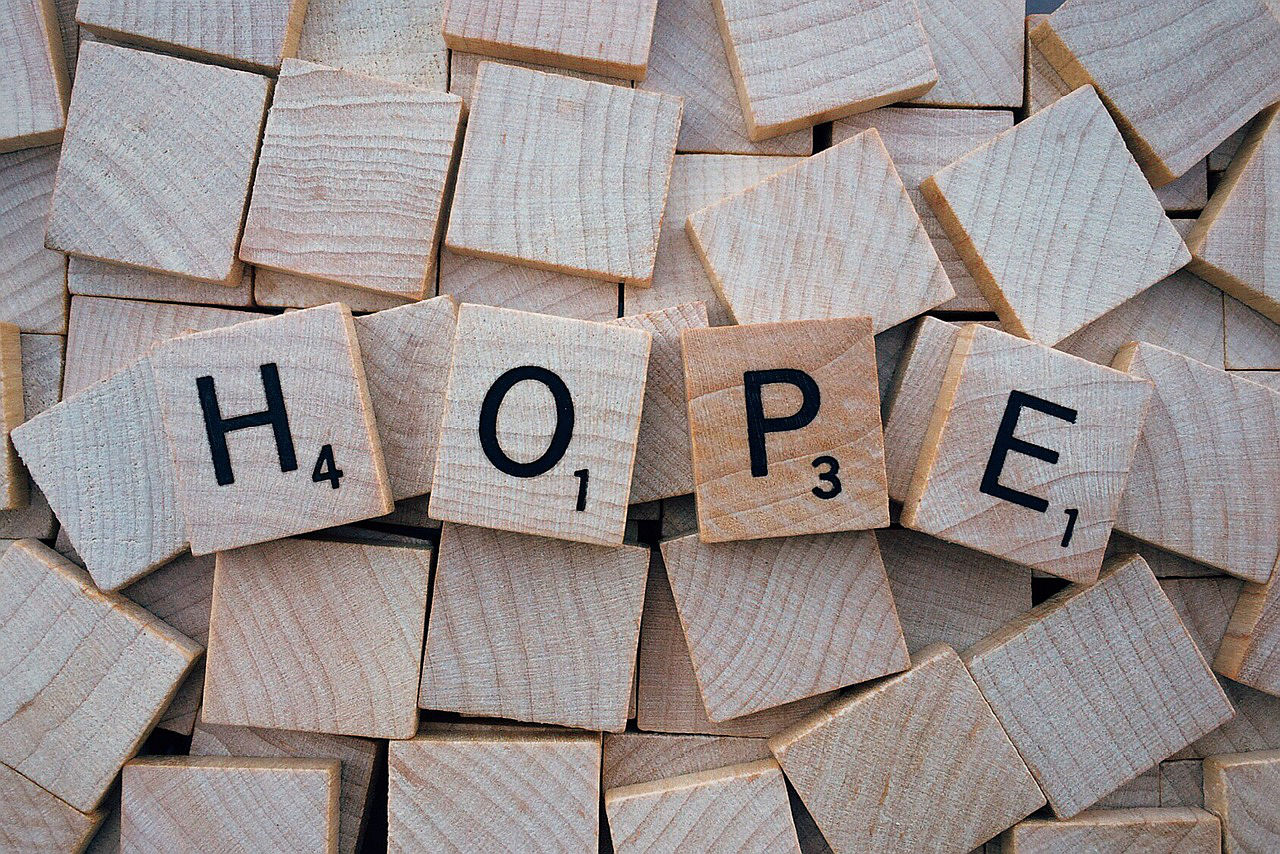
(Image courtesy of Pixabay)
7. The Power of Cocoa
Grumpy? Try some dark chocolate. Works for me. This one in particular.
But anecdotal evidence can only get you so far. So the fine folks at Swinburne University proposed an experiment published in 2013 designed to examine if chocolate really does improve mood. What the numbers show is that of their 72 participants, the ones who drank a dark chocolate beverage containing 500mg of polyphenols—the rough equivalent of 30g (or 4 squares) of my favorite chocolate in the world—for 30 days straight showed “increased self-rated calmness and contentedness relative to placebo” [15]. Immediacy of effect was an issue though. One dose didn’t seem to do much in the short-term.
However, some studies [16, 17] have successfully shown an association between chocolate or cocoa consumption and positive effects on mood within minutes. But overall? We’re still in the inconclusive phase. So chocolate might improve mood quickly. Or it might not. We need more studies to get a clearer answer.
On topic, research from University of L’Aquila and Sapienza in Rome published last May point to chocolate not only enhancing cognition, but preventing age-related mental decline [18]. The team encourages researchers to come up with complex experimental designs involving neuroimaging techniques to get to the bottom of what chocolate does to the brain.
Not planning on waiting for those studies to give the official green light? Me neither. Oh, and stick to dark chocolate with at least 70% cocoa content if you can. It allegedly provides more health benefits.

References
- Song CH, Jung JH, Oh JS, Kim KS. Effects of theanine on the release of brain alpha wave in adult males. Korean J Nutr. 2003; 36(9): 918-923.
- Nobre AC, Rao A, Owen GN. L-theanine, a natural constituent in tea, and its effect on mental state. Asia Pac J Clin Nutr. 2008;17 Suppl 1:167-8.
- Heck DH, McAfee SS, Liu Y, et al. Breathing as a fundamental rhythm of brain function. Frontiers in Neural Circuits 2016; 10: 115.
- MPham WS, Siripornpanich V,Piriyapunyaporn T, Hongratanaworakit T, Kotchabhakdi N, Ruangrungsi N. The effects of lavender oil inhalation on emotional states, autonomic nervous system, and brain electrical activity. J Med Assoc Thai 2012; 95 (4): 598-606.
- Kasper S, Gastpar M, Müller WE, Volz HP, Möller HJ, Schläfke S, Dienel A; Lavender oil preparation Silexan is effective in generalized anxiety disorder – a randomized, double-blind comparison to placebo and paroxetine. International Journal of Neuropsychopharmacology 2014; 17(6): 859–869.
- Kasper S, Müller WE, Volz HP, Möller HJ, Koch E, Dienel A. Silexan in anxiety disorders: Clinical data and pharmacological background. World J Biol Psychiatry 2017; 19: 1-9.
- Woelk H, Schläfke S. A multi-center, double-blind, randomised study of the lavender oil preparation Silexan in comparison to Lorazepam for generalized anxiety disorder. Phytomedicine 2010; 17(2): 94–99.
- Bargh JA, Shalev I. The substitutability of physical and social warmth in daily life. Emotion 2012; 12(1): 154-162.
- Morris N. The effects of lavender (Lavendula angustifolium) baths on psychological well-being: two exploratory randomised control trials. Complement Ther Med. 2002; 10(4): 223-8.
- Gordon B. In hot water? Have a bath and relax. The Telegraph 2002 Oct 12.
- Ford BQ, Lam P, John OP, Mauss IB. The psychological health benefits of accepting negative emotions and thoughts: Laboratory, diary, and longitudinal evidence. Journal of Personality and Social Psychology 2017 Jul 13.
- Baer RA, Smith GT, Hopkins J, Krietemeyer J, Toney L. Using self-report assessment methods to explore facets of mindfulness. Assessment 2006 Mar; 13(1): 27-45.
- Goldin PR, McRae K, Ramel W, Gross JJ. The neural bases of emotion regulation: Reappraisal and suppression of negative emotion. Biological Psychiatry. 2008;63(6):577-586.
- Lieberman MD, Eisenberger NI, Crockett MJ, Tom SM, Pfeifer JH, Way BM. Putting feelings into words: Affect labeling disrupts amygdala activity in response to affective stimuli. Psychological Science 2007; 18(5): 421-428.
- Pase MP, Scholey AB, Pipingas A, Kras M, Nolidin K, Gibbs A, Wesnes K, Stough C. Cocoa polyphenols enhance positive mood states but not cognitive performance: A randomized, placebo-controlled trial. Journal of Psychopharmacology 2013; 27(5): 451-458.
- Scholey AB, French SJ, Morris PJ, Kennedy DO, Milne AL, Haskell CF. Consumption of cocoa flavanols results in acute improvements in mood and cognitive performance during sustained mental effort. Journal of Psychopharmacology 2010; 24(10): 1505-14.
- Scholey A, Owen L. Effects of chocolate on cognitive function and mood: a systematic review.Nutr Rev. 2013; 71(10): 665-81.
- Socci V, Tempesta D, Desideri G, De Gennaro L, Ferrara M. Enhancing Human Cognition with Cocoa Flavonoids. Frontiers in Nutrition, 16 May 2017.
These 7 ways to feel better right now using neuroscience go beyond the vague tips we’ve all heard before, well-meaning yet often unhelpful advice repeated ad nauseum. These seven strategies actually work, and they work fast, altering brainwaves and dampening destructive stress responses in the body in matter of seconds.
1. Drink Tea
I don’t just drink tea because it tastes good. The beverage is a boon for the brain. And mood.
The tea plant otherwise known as camellia sinensis is one of the only edible substances in the world known to contain L-theanine, an organic compound occasionally nicknamed the “relaxation amino acid” courtesy of its remarkable calming effects.
Traces of L-theanine have been found in a couple of flower species and the Bay Bolete mushroom, but good luck finding that fungus in abundance.
The beauty of L-theanine is it facilitates the generation of alpha waves in the brain [1, 2] the same kind of state that lifelong meditators (and elite athletes) can produce on demand. On topic, one of my best meditation sessions on record –call me a neurogeek, but I never tire of recording my brainwaves– occurred right after finishing up a café-au-lait-sized cup of matcha.
Coincidence?
See Also: Green Tea Weight Loss Miracle: Truth Or Hype?
And: Want a Better Memory? Do This

(Photo courtesy of Pixabay)
What’s especially fascinating about being in an alpha state is its association with boosts of creativity and productivity devoid of feelings of anxiety, stress, and depression. Alpha brainwaves denote both a sense of relaxation and focused attention. Incidentally, evidence points to tea producing that very effect, a sense of calm and paradoxically, enhanced alertness. The best of both worlds, I say.
2. Breathe the Right Way
Breathing is so underrated. Most people do it wrong too. In fact, most people do it so wrong, they open themselves up to insomnia, neck, back, and shoulder pain, indigestion, memory problems, and even anxiety that could be minimized or maybe even put to rest altogether by fundamentally changing the way they breathe.
Author of Breathe, psychologist Dr. Belisa Vranich, certainly isn’t the first to suggest that breathing significantly changes brain function [3]. But she’s one of the first to explain how to do it the right way so simply. Delving into the anatomy of what Dr. Vranich qualifies as good breathing, she claims in the following two-minute clip that filling up your lungs “horizontally” rather than “vertically” is key to improving quality of life.
3. Acknowledge Panic Away
What do you do in the throes of a panic attack? Countless articles detail the process. I’ll share with you I figured out for myself through a combination of deduction and sheer dumb luck, in a time long ago before copycat how-tos proliferated on the web, a time before the creation of Youtube and even Google (I know, crazy talk).
So this is what killed my panic attacks as a first year psychology student. And if you fast-forward to Strategy #6 on this list, you’ll see that what I did has since been confirmed by neuroscience as effective.
The attacks started two weeks before I was about to be kicked out of home. It was a shock to the system. I wasn’t given enough notice to prepare nor build up sufficient savings to keep me afloat as I was about to start university. In the –for lack of a better word– panic to find a new home, I ended up taking the cheapest apartment I could find that wasn’t a complete dump.
It was in a public housing project complemented by a violent man prone to beating his mother to tears. They lived right above me and I could hear everything, the cries, the pleas, the punches, the wall slams. He didn’t take long to notice that I might make him an interesting mark too, right around the time I tried to convince his mother that a butcher knife aimed in her general direction might be a choice time for her to run and call the police. It was… not good.

(Photo courtesy of Pexels)
So what quashed my panic attacks? Awareness and loving kindness towards myself. Awareness was the realization that my reaction to the physical symptoms of a building attack was what escalated the situation into uncontrollable hyperventilation. And being gentle with myself by accepting that it was okay that this was happening was the loving kindness.
The first sign that I was about to have an attack was body heat. If I started to feel overheated and the next thing to happen was a rapid heart rate, it wouldn’t take long for shallow breathing to kick in. Seconds after that? The sensation that my chest was about to explode. The first time that ever happened, I thought I was dying, a horrifying sensation.
Learning to spot the signs that came before that crushing, breathless feeling was key. Awareness.
If I suddenly felt a little too hot or if my heart rate was speeding up without there being a valid physical reason for it, then it was my cue to consciously work on taking longer, slower breaths, the kind of inhales that make you feel like you’re filling up your belly, not your chest, precisely how Vranich advised in that breathing clip I posted above.
It took practice, but I was eventually able to “move through” the panic faster and faster.
If I was alone, I would talk to myself out loud too, saying things like “this will pass sweets, you’re fine, you’re okay, it’s a physical thing that happens to a lot of people, and you’ll get through it.” That’s loving kindness.
Even simply acknowledging to myself that “oh, you’re on the verge of a panic attack but it’s all good” or “oh, you’re having a panic attack and, hey, it’s okay” was enough to give me a gradual sense of control over my breath and an understanding that no matter how terrified I might feel, it can take but a matter of seconds to get into a better-feeling place.
Even simply acknowledging to myself that “oh, you’re on the verge of a panic attack but it’s all good” or “oh, you’re having a panic attack and, hey, it’s okay” was enough to give me a gradual sense of control over my breath and an understanding that no matter how terrified I might feel, it can take but a matter of seconds to get into a better-feeling place.
In other words? This too, shall pass. And it did.
My life circumstances were still as taxing as ever, yet within weeks, the panic attacks were gone.

That’s me in a lavender field in the province of Quebec’s Eastern Townships. (Photo © Clint Lewis)
4. Stop and Smell the Roses Lavender
I don’t have a vial of the flower essence on my desk for nothing. Anecdotal claims qualifying lavender as a calming, mood-lifting agent have been put to the clinical test for decades.
Take a 2012 Thai study which discovered that subjects with 31 electroencephalogram (EGG) electrodes strapped to their heads showed sudden increased alpha and theta brainwave activity as they inhaled lavender oil, brain activity consistent with deep relaxation [4]. That’s also the kind of pattern you’d see an experienced meditator induce and sustain during a meditation session.
Participants who inhaled sweet almond oil in the same Thai study showed no such shift in brainwave activity.
Blood pressure dropped and heart rate activity also slowed down for lavender sniffers who reported “feeling better, fresher, more active, more relaxed, and less drowsy” afterward.
All this, just from smelling the flower essence.
Meanwhile, the sweet almond oil group weren’t quite as delighted, describing the sensation as “unpleasant when sweet almond oil was applied, with data showing decreased scores in good, active, fresh and relaxed feelings.”
The study sample size, 20 people, is admittedly small, participants had their respective oils pumped through an oxygen mask –not quite the same as casually sniffing lavender at your desk, is it– and there is the possibility that researchers unwittingly affected the outcome of the study since its design was not double-blind.
But what if they’re onto something nonetheless?

(Photo courtesy of Pixabay)
A robust 2014 German study involving 539 patients diagnosed with generalized anxiety disorder (GAD) found that a lavender oil preparation called Silexan taken orally was as effective in treating anxiety over a 10-week period as paroxetine (aka Paxil) [5].
Paroxetine is an effective and popular antidepressant and antianxiety medication notorious for unpleasant, sometimes life-disrupting discontinuation symptoms experienced by about 20% of users weaning off the drug. In contrast, no withdrawal symptoms nor drug interactions have been found with the lavender oil preparation in a subsequent study conducted earlier this year [6].
Equally fascinating is how in 2010, a duo of German researchers who conducted a double-blind experiment involving 221 adults also diagnosed with GAD saw the same previously mentioned lavender oil preparation offer comparable relief from anxiety as Lorazepam (aka Ativan), a powerful benzodiazepine commonly prescribed for anxiety and insomnia [7]. Lorazepam offers relief, yes, but it also induces a woozy, dreamy, drowsy mental state that slows reaction time, leading to bouts of confusion and memory loss, hampering work performance, the ability to safely drive a vehicle, even interfering with the ability to carry on a conversation at times. Then there’s the high risk of addiction and rapid tolerance formation.
Lavender? None of these problems have been detected with ongoing use of the humble flower essence. Possible side effects discovered to date are nausea and dyspepsia if taken orally, and potential skin dermatitis if the essential oil is applied directly to the skin. But otherwise, that’s it.
The above is but a sliver of the surprising amount of research out there supporting lavender as an anxiolytic. The scientific and medical community are slowly, skeptically coming around as more solidly-designed studies come forward showing equally promising results.
At this point? The best case scenario is lavender really is all that, and possibly more. The worse case scenario is that evidence of its effectiveness in calming, reducing stress, enhancing focus, and improving the sleep of its users may be overstated.
A 2012 Thai study discovered that subjects with 31 electroencephalogram (EGG) electrodes strapped to their heads showed sudden increased alpha and theta brainwave activity when they inhaled lavender oil, brain activity consistent with deep relaxation. That’s also the kind of pattern you’d see an experienced meditator induce and sustain during a meditation session.

(Photo courtesy of Pixabay)
5. Take a Hot Bath
Feeling low? Maybe even lonely? Get thee to thy bath.
An in-depth 2012 study conducted by Yale University demonstrated that warm or hot baths soothed feelings of loneliness [8].
And a 2002 University of Wolverhampton study [9], which saw psychologist Neil Morris evaluating the moods of 80 participants instructed to take daily baths for two weeks found “that bathing improved general psychological wellness radically. There was a significant drop in feelings of pessimism about the future and increases in hedonic tone, the internal feeling of pleasurability,” as per Morris [10].
He adds, “I believe that the results could be even more impressive over a longer period of time. Baths give you the chance to stop the day for a few minutes, in a way that showers can’t. There is a wonderful combination of isolation, quiet and comfort.”
And you’ll never guess what Morris had some participants add to the bathwater.
Lavender.
Those who did have lavender oil added to their baths showed greater drops in anger, frustration, and pessimistic thought towards the future than those who bathed with comparable amounts of grapeseed oil instead.

(Photo courtesy of Pixabay)
6. Accept and Label Negative Emotions As They Happen
“Mindfulness is simply being aware of what is happening right now without wishing it were different; enjoying the pleasant without holding on when it changes (which it will); [and] being with the unpleasant without fearing it will always be this way (which it won’t).” -meditation teacher James Baraz
Remember what I said earlier about how acknowledging and accepting that I was experiencing a panic attack seemed to help me move through it? I was unwittingly engaging in a process called mindfulness. Yogis and Buddhist monks have been practicing it for generations and mental health professionals have taken note.
For example, a research team from University of California, Berkeley and University of Toronto [11] looked closely at the impact of acceptance, a facet of mindfulness [12]. They conclude in the report detailing a trio of studies published earlier this year in the Journal of Personality and Social Psychology that accepting negative emotions leads to less negative emotions.
Compelling paradox, isn’t it? Regularly facing and accepting one’s negative emotional experiences instead of judging them as bad or inappropriate actually appears to lead to feeling those negative emotions less intensely.
All three studies conducted by the UC Berkeley and U of Toronto team conclude the same thing: participants who tended to accept their negative emotions on a day-to-day basis experienced them to a lesser degree and were also inclined to exhibit greater psychological health than those who judged their negative emotions.
Those same researchers actively caution against suppressing negative emotions, a tragically common social expectation imposed on us at work and at home among friends and family. Forcing oneself to think positively or least hide negative thoughts or feelings from everyone instead of processing them as they happen may be actively worsening mental well-being.
A 2008 Stanford University study [13] confirmed a decade prior that suppressing a negative emotion did not shut down the stress response in the brain at all. The negative emotion appeared successfully suppressed since there was no evidence of it on the participants’ faces, but the fight-or-flight anxiety activation of the amygdala and insula was as prominent as ever. Neurologically-speaking, the brain was reacting to a threat even though there was no behavioral sign of it.
So if acceptance is key, how does one go about doing that? How do you shut down the stress response?
Label the feeling. It takes but a second to do that and a few seconds more for the brain to shift gears.
Giving the negative emotion a name as it’s experienced in real time appears to not only reduce its intensity but lessens its impact on the brain. Is it anger? Hopelessness? Sadness? Call it out for what it is. Acknowledge it. To quote the opening paragraph of a 2007 UCLA study examining the neurobiology of labeling [14], “putting feelings into words has long been thought to be one of the best ways to manage negative emotional experiences.”
What they discovered was that when participants were asked to give a negative emotion a name, their right ventrolateral prefrontal cortex lit up and when that happened, their amygdala, a region of the brain that reacts to stimulus considered threatening or dangerous, simmered itself down, a consistent result found in other studies examining the impact of labelling emotions as they happen. Processing negative emotions with words seems to deactivate the “threat” center of the brain.
Labeling, acknowledging, accepting… sounds a bit like mindfulness, doesn’t it?

(Photo courtesy of Pixabay)
7. The Power of Cocoa
Grumpy? Try some dark chocolate. Works for me. This one in particular.
But anecdotal evidence can only get you so far. So the fine folks at Swinburne University proposed an experiment published in 2013 designed to examine if chocolate really does improve mood. What the numbers show is that of their 72 participants, the ones who drank a dark chocolate beverage containing 500mg of polyphenols—the rough equivalent of 30g (or 4 squares) of my favorite chocolate in the world—for 30 days straight showed “increased self-rated calmness and contentedness relative to placebo” [15]. Immediacy of effect was an issue though. One dose didn’t seem to do much in the short-term.
However, some studies [16, 17] have successfully shown an association between chocolate or cocoa consumption and positive effects on mood within minutes. But overall? We’re still in the inconclusive phase. So chocolate might improve mood quickly. Or it might not. We need more studies to get a clearer answer.
On topic, research from University of L’Aquila and Sapienza in Rome published last May point to chocolate not only enhancing cognition, but preventing age-related mental decline [18]. The team encourages researchers to come up with complex experimental designs involving neuroimaging techniques to get to the bottom of what chocolate does to the brain.
Not planning on waiting for those studies to give the official green light? Me neither. Oh, and stick to dark chocolate with at least 70% cocoa content if you can. It allegedly provides more health benefits.

References
- Song CH, Jung JH, Oh JS, Kim KS. Effects of theanine on the release of brain alpha wave in adult males. Korean J Nutr. 2003; 36(9): 918-923.
- Nobre AC, Rao A, Owen GN. L-theanine, a natural constituent in tea, and its effect on mental state. Asia Pac J Clin Nutr. 2008;17 Suppl 1:167-8.
- Heck DH, McAfee SS, Liu Y, et al. Breathing as a fundamental rhythm of brain function. Frontiers in Neural Circuits 2016; 10: 115.
- MPham WS, Siripornpanich V,Piriyapunyaporn T, Hongratanaworakit T, Kotchabhakdi N, Ruangrungsi N. The effects of lavender oil inhalation on emotional states, autonomic nervous system, and brain electrical activity. J Med Assoc Thai 2012; 95 (4): 598-606.
- Kasper S, Gastpar M, Müller WE, Volz HP, Möller HJ, Schläfke S, Dienel A; Lavender oil preparation Silexan is effective in generalized anxiety disorder – a randomized, double-blind comparison to placebo and paroxetine. International Journal of Neuropsychopharmacology 2014; 17(6): 859–869.
- Kasper S, Müller WE, Volz HP, Möller HJ, Koch E, Dienel A. Silexan in anxiety disorders: Clinical data and pharmacological background. World J Biol Psychiatry 2017; 19: 1-9.
- Woelk H, Schläfke S. A multi-center, double-blind, randomised study of the lavender oil preparation Silexan in comparison to Lorazepam for generalized anxiety disorder. Phytomedicine 2010; 17(2): 94–99.
- Bargh JA, Shalev I. The substitutability of physical and social warmth in daily life. Emotion 2012; 12(1): 154-162.
- Morris N. The effects of lavender (Lavendula angustifolium) baths on psychological well-being: two exploratory randomised control trials. Complement Ther Med. 2002; 10(4): 223-8.
- Gordon B. In hot water? Have a bath and relax. The Telegraph 2002 Oct 12.
- Ford BQ, Lam P, John OP, Mauss IB. The psychological health benefits of accepting negative emotions and thoughts: Laboratory, diary, and longitudinal evidence. Journal of Personality and Social Psychology 2017 Jul 13.
- Baer RA, Smith GT, Hopkins J, Krietemeyer J, Toney L. Using self-report assessment methods to explore facets of mindfulness. Assessment 2006 Mar; 13(1): 27-45.
- Goldin PR, McRae K, Ramel W, Gross JJ. The neural bases of emotion regulation: Reappraisal and suppression of negative emotion. Biological Psychiatry. 2008;63(6):577-586.
- Lieberman MD, Eisenberger NI, Crockett MJ, Tom SM, Pfeifer JH, Way BM. Putting feelings into words: Affect labeling disrupts amygdala activity in response to affective stimuli. Psychological Science 2007; 18(5): 421-428.
- Pase MP, Scholey AB, Pipingas A, Kras M, Nolidin K, Gibbs A, Wesnes K, Stough C. Cocoa polyphenols enhance positive mood states but not cognitive performance: A randomized, placebo-controlled trial. Journal of Psychopharmacology 2013; 27(5): 451-458.
- Scholey AB, French SJ, Morris PJ, Kennedy DO, Milne AL, Haskell CF. Consumption of cocoa flavanols results in acute improvements in mood and cognitive performance during sustained mental effort. Journal of Psychopharmacology 2010; 24(10): 1505-14.
- Scholey A, Owen L. Effects of chocolate on cognitive function and mood: a systematic review.Nutr Rev. 2013; 71(10): 665-81.
- Socci V, Tempesta D, Desideri G, De Gennaro L, Ferrara M. Enhancing Human Cognition with Cocoa Flavonoids. Frontiers in Nutrition, 16 May 2017.









